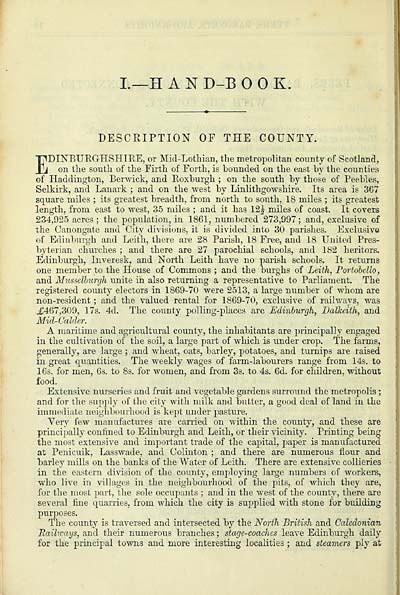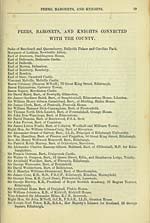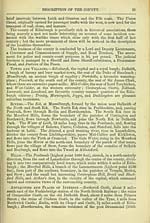Download files
Complete book:
Individual page:
Thumbnail gallery: Grid view | List view

L— H A N D-B K.
DESCRIPTION OF THE COUNTY.
EDINBURGHSHIRE, or Mid-Lothian, the metropolitan county of Scotland,
on the south of the Firth of Forth, is bounded on the east by the counties
of Haddington, Berwick, and Roxburgh ; on the south by those of Peebles,
Selkirk, and Lanark ; and on the west by Linlithgowshire. Its area is 367
square miles ; its greatest breadth, from north to south, 18 miles ; its greatest
length, from east to west, 35 miles ; and it has 12^ miles of coast. It covers
234,925 acres ; the population, in 1861, numbered 273,997 ; and, exclusive of
the Canongate and City divisions, it is divided into 30 parishes. Exclusive
of Edinburgh and Leith, there are 28 Parish, 18 Free, and 18 United Pres-
byterian churches ; and there are 27 parochial schools, and 182 heritors.
Edinburgh, Inveresk, and North Leith have no parish schools. It returns
one member to the House of Commons ; and the burghs of Leith, Portobello,
and Musselburgh unite in also returning a representative to Parliament. The
registered county electors in 1869-70 were 2513, a large number of whom are
non-resident ; and the valued rental for 1869-70, exclusive of railways, was
,£467,309, 17s. 4d. The county polling-places are Edinburgh, Dalkeith, and
Mid-Calder.
A maritime and agricultural county, the inhabitants are principally engaged
in the cultivation of the soil, a large part of which is under crop. The farms,
generally, are large ; and wheat, oats, barley, potatoes, and turnips are raised
in great quantities. The weekly wages of farm-labourers range from 14s. to
16s. for men, 6s. to 8s. for women, and from 3s. to 4s. 6d. for children, without
food.
Extensive nurseries and fruit and vegetable gardens surround the metropolis ;
and for the supply of the city with milk and butter, a good deal of land in the
immediate neighbourhood is kept under pasture.
Very few manufactures are carried on within the county, and these are
principally confined to Edinburgh and Leith, or their vicinity. Printing being
the most extensive and important trade of the capital, paper is manufactured
at Penicuik, Lasswade, and Colinton ; and there are numerous flour and
barley mills on the banks of the Water of Leith. There are extensive collieries
in the eastern division of the county, employing large numbers of workers,
who live in villages in the neighbourhood of the pits, of which they are,
for the most part, the sole occupants ; and in the west of the county, there are
several fine quarries, from which the city is supplied with stone for building
purposes.
The county is traversed and intersected by the North British and Caledonian
Railways, and their numerous branches ; stage-coaches leave Edinburgh daily
for the principal towns and more interesting localities ; and steamers ply at
DESCRIPTION OF THE COUNTY.
EDINBURGHSHIRE, or Mid-Lothian, the metropolitan county of Scotland,
on the south of the Firth of Forth, is bounded on the east by the counties
of Haddington, Berwick, and Roxburgh ; on the south by those of Peebles,
Selkirk, and Lanark ; and on the west by Linlithgowshire. Its area is 367
square miles ; its greatest breadth, from north to south, 18 miles ; its greatest
length, from east to west, 35 miles ; and it has 12^ miles of coast. It covers
234,925 acres ; the population, in 1861, numbered 273,997 ; and, exclusive of
the Canongate and City divisions, it is divided into 30 parishes. Exclusive
of Edinburgh and Leith, there are 28 Parish, 18 Free, and 18 United Pres-
byterian churches ; and there are 27 parochial schools, and 182 heritors.
Edinburgh, Inveresk, and North Leith have no parish schools. It returns
one member to the House of Commons ; and the burghs of Leith, Portobello,
and Musselburgh unite in also returning a representative to Parliament. The
registered county electors in 1869-70 were 2513, a large number of whom are
non-resident ; and the valued rental for 1869-70, exclusive of railways, was
,£467,309, 17s. 4d. The county polling-places are Edinburgh, Dalkeith, and
Mid-Calder.
A maritime and agricultural county, the inhabitants are principally engaged
in the cultivation of the soil, a large part of which is under crop. The farms,
generally, are large ; and wheat, oats, barley, potatoes, and turnips are raised
in great quantities. The weekly wages of farm-labourers range from 14s. to
16s. for men, 6s. to 8s. for women, and from 3s. to 4s. 6d. for children, without
food.
Extensive nurseries and fruit and vegetable gardens surround the metropolis ;
and for the supply of the city with milk and butter, a good deal of land in the
immediate neighbourhood is kept under pasture.
Very few manufactures are carried on within the county, and these are
principally confined to Edinburgh and Leith, or their vicinity. Printing being
the most extensive and important trade of the capital, paper is manufactured
at Penicuik, Lasswade, and Colinton ; and there are numerous flour and
barley mills on the banks of the Water of Leith. There are extensive collieries
in the eastern division of the county, employing large numbers of workers,
who live in villages in the neighbourhood of the pits, of which they are,
for the most part, the sole occupants ; and in the west of the county, there are
several fine quarries, from which the city is supplied with stone for building
purposes.
The county is traversed and intersected by the North British and Caledonian
Railways, and their numerous branches ; stage-coaches leave Edinburgh daily
for the principal towns and more interesting localities ; and steamers ply at
Set display mode to: Large image | Transcription
Images and transcriptions on this page, including medium image downloads, may be used under the Creative Commons Attribution 4.0 International Licence unless otherwise stated. ![]()
| Scottish Post Office Directories > Counties > Midlothian (Edinburghshire) > Edinburgh county directory > (26) |
|---|
| Permanent URL | https://digital.nls.uk/85990447 |
|---|
| Description | Directories of individual Scottish counties or parts of counties. |
|---|
| Description | Around 700 Scottish directories published annually by the Post Office or private publishers between 1773 and 1911. Most of Scotland covered, with a focus on Edinburgh, Glasgow, Dundee and Aberdeen. Most volumes include a general directory (A-Z by surname), street directory (A-Z by street) and trade directory (A-Z by trade). |
|---|


